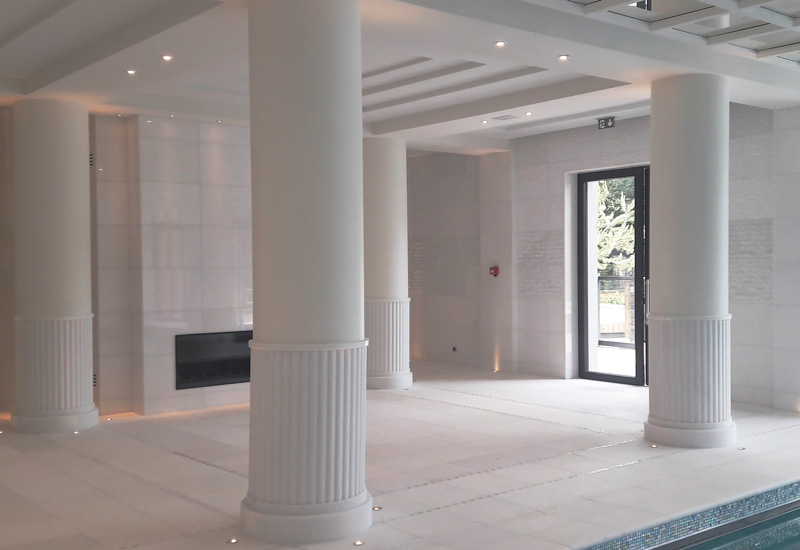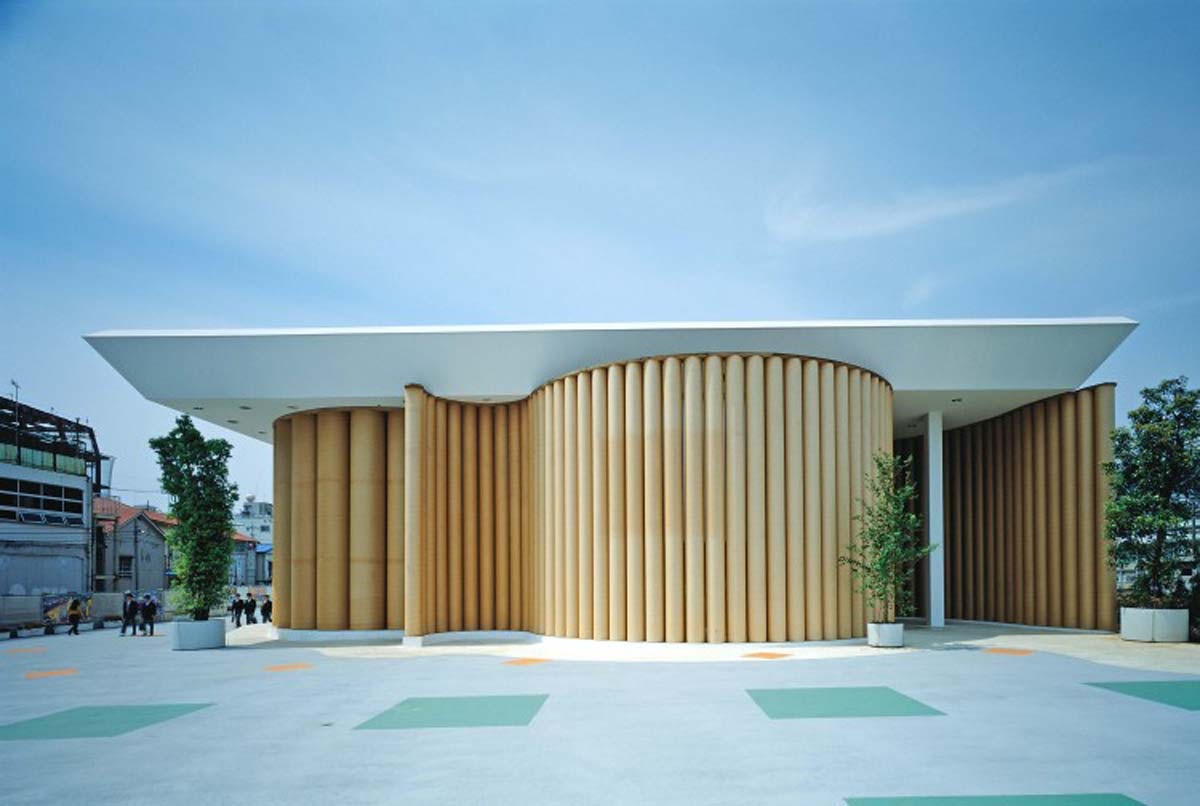Modern architecture shapes the world around us with its bold designs and innovative structures. Pillars in this design realm are not just supports; they’re key elements that define space and style.
The very essence of modern architecture rests on the strengths of these pillars, both literally and metaphorically. They are more than mere functional components; pillars in modern architecture embody the blend of form and function that stands at the core of contemporary design.
These structural marvels carry the weight of buildings and the aspirations of architects, bridging the gap between artistic vision and engineering reality. Understanding pillars in modern architecture is crucial for anyone interested in the field of design or simply appreciating the built environment. These supports do more than hold up a structure; they speak a language of aesthetics unique to our times. They can be sleek and minimal or bold and expressive, often reflecting the ethos of an era. As we delve into the world of modern architecture, we explore not just the physical attributes of these pillars but also their symbolic significance. Join us as we uncover the role pillars play in crafting spaces that are not only functional but also transformative.
The Evolution Of Pillars In Architecture
The evolution of pillars in architecture tells a story of human innovation. These structures have come a long way. They started as simple tree trunks. Now, they are complex designs made with cutting-edge materials. Let’s explore this journey.
From Ancient Greece To Modern Marvels
Ancient Greeks crafted pillars with precision. They carved them out of stone. Roman architects then took these designs further. They built grand structures. Pillars became symbols of strength and beauty.
- Doric, Ionic, and Corinthian styles emerged.
- Each style had its own flair and purpose.
Fast forward to today, modern marvels have transformed pillars. They are no longer just for support. They are also for aesthetics. Architects use them to make bold statements.
Technological Advances Shaping Design
Technology has changed how we design pillars. New materials and methods allow for more creativity. Steel and concrete are common now. They let architects build higher and bolder.
| Material | Benefits |
|---|---|
| Steel | Strength, flexibility |
| Concrete | Durability, versatility |
| Composites | Lightweight, modern look |
Computer software now helps in design. It makes complex shapes possible. These shapes were once only dreamed. Now, they are real structures in our cities.

Credit: www.rouveure-marquez.com
Materials Redefining Strength And Aesthetics
Modern architecture stands on materials that blend strength with beauty. These elements shape today’s skyline and echo through the pillars that hold up our grandest structures. Let’s explore the materials that are redefining the world of architecture.
Concrete And Steel: The Backbone Of Modern Pillars
Concrete and steel are the heroes of urban landscapes. These materials have been the choice for architects for ages. They offer unmatched durability and flexibility in design. Together, they form the core of modern pillars, supporting towering skyscrapers and sprawling bridges.
Innovative Materials And Sustainable Solutions
Architects are now embracing new materials. These include carbon fiber and engineered wood. They aim for sustainability and efficiency. Such materials reduce carbon footprints and still provide the strength needed for modern pillars. They are the future of eco-friendly design, promising a greener planet.
Iconic Pillared Structures Around The World
Exploring Iconic Pillared Structures Around the World reveals how pillars shape modern architecture. These structures stand as symbols of innovation and beauty. Each has its own story, blending design with functionality.
The Burj Khalifa: A Testament To Modern Engineering
The Burj Khalifa in Dubai reaches the sky. It is the tallest building in the world. Its design includes many pillars. These pillars are not just for show. They support the building’s massive weight. The Burj Khalifa shows how modern engineering can create wonders.
- Location: Dubai, UAE
- Height: 828 meters
- Pillars: Support and design
The Lotus Temple: Blending Spirituality With Modern Design
The Lotus Temple is in New Delhi. It looks like a lotus flower. This design is unique. It mixes spirituality with modern looks. The temple has 27 pillars. These pillars form the shape of a lotus. They show how architecture can connect with nature.
- Location: New Delhi, India
- Shape: Lotus flower
- Pillars: 27, forming a lotus
The Functionality Of Pillars Beyond Support
Pillars in modern architecture do more than hold up buildings. They blend form and function. They shape space and express artistic ideas. Let’s explore how pillars serve beyond mere support.
Aesthetic Significance In Contemporary Architecture
Pillars have evolved. Today, they’re key design elements. Architects use them to create rhythm and interest. They turn ordinary spaces into visual poems. Pillars now tell stories, reflecting culture and context.
- Shapes and sizes vary, adding unique character.
- Materials range from classic stone to transparent glass.
- Colors and textures contribute to a building’s personality.
Energy Efficiency And Environmental Considerations
Modern pillars think green. They help manage light and air. This reduces energy needs. They also use sustainable materials. Pillars can now help buildings blend with nature.
| Feature | Benefit |
|---|---|
| Thermal Mass | Stores heat, stabilizes temperature |
| Hollow Design | Allows air flow, improves ventilation |
| Green Materials | Reduces environmental impact |
Design Principles For Modern Pillars
Pillars are key in modern architecture. They support structures and add beauty. Good design blends look with strength. Let’s explore how to make modern pillars work well.
Balancing Form And Function
Modern pillars must look good and be strong. They hold up buildings and catch the eye. Designers think about size, shape, and material. The goal is to make pillars that fit the building’s style and last long. The best pillars work well and add to the building’s beauty.
Integrating Technology And Design
Technology changes how we make pillars. We use new tools and materials. This lets us build in new ways. Pillars can now do more than just support. They can hide wires and pipes. Some even clean the air. Designers use tech to make pillars smarter and better.
Related Article: Modern Vs Postmodern Architecture: A Visual Guide

Credit: architizer.com
Related Article: Contemporary Architecture: Trends Shaping Modern Skylines
Challenges In Constructing Modern Pillared Edifices
Building modern pillared buildings is tough. Architects and builders face many problems. These include dealing with city rules and making sure the building lasts long and is safe. Let’s explore these challenges more.
Navigating Environmental And Urban Constraints
Cities are crowded. Space is limited. Putting up new structures with pillars needs careful planning. Builders must think about the environment too. They must not harm nature while building. This balance is hard to find.
Ensuring Durability And Safety
Buildings must stand strong for years. They must be safe for everyone inside. This means using the right materials and designs. It’s important to test everything. This ensures the building can face storms, earthquakes, and more.
Future Trends In Pillar Design
The world of architecture constantly evolves, and pillars are no exception. The future of pillar design is shaping up to be exciting and innovative. Architects and engineers focus on new materials and designs that change how we think about support structures.
Smart Materials And Responsive Design
Pillars aren’t just static anymore. They adapt and respond now. Smart materials allow pillars to change based on weather, load, or even aesthetic needs. Think of materials that tighten or expand with temperature. This means buildings become more than just structures; they’re interactive systems. These pillars can also gather data, helping buildings to be smarter and safer.
Sustainability And Green Building Techniques
Going green isn’t just a trend; it’s a necessity. Pillars made of recycled materials are on the rise. They’re strong yet kind to the planet. Builders use bamboo, reclaimed wood, or even recycled plastics. These materials cut down on waste and reduce the carbon footprint of new constructions. Green pillars are part of a bigger push for eco-friendly architecture that lasts for generations.
Related Article: Pillars in Modern Architecture: Structural Icons

Credit: www.pinterest.com
Related Article: What Characteristics Identify Early Modern Architecture – A Complete Guide
Educational And Cultural Significance Of Pillars
Pillars in modern architecture are more than just structural elements. They tell stories of our past, present, and future. These towering columns do not just support buildings; they also uphold our cultural and educational values. Let’s explore how.
Pillars As Symbols Of Innovation And Progress
Pillars showcase our growth in design and technology. Each new structure reflects the latest advances. They stand tall, showing the world our ability to innovate. These structures are a visible sign of our progress. They push us to keep improving and moving forward.
Inspiring Future Generations Of Architects And Engineers
Young minds look at pillars and dream. They see possibility and challenge. Pillars in schools and museums teach lessons of physics and art. They encourage learning and spark creativity. Each pillar can lead a child to become the next great architect or engineer.
Conclusion
Modern architecture stands on key principles that shape our skylines. These pillars reflect innovation, sustainability, and functionality. They ensure buildings meet today’s needs without compromising beauty. Architects blend form with purpose, creating spaces that inspire and endure. Remember these cornerstones next time you admire a modern marvel.
They’re not just structures. They’re testaments to human creativity and progress. Let’s appreciate these architectural achievements that transform our daily lives.
Related Article: Brutalist Architecture Characteristics: Unveiling Bold Design Elements
